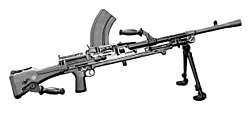 | |
| Company type | Private limited company |
|---|---|
| Industry | Firearm |
| Headquarters | Brno , Czech Republic |
| Parent | Colt-CZ Group |
| Website | www |

Zbrojovka Brno, s.r.o. is a small arms manufacturer based in Brno, Czech Republic. It's a wholly owned subsidiary of Colt-CZ Group.
Contents
- History
- Products
- Firearms
- Motor vehicles
- Typewriters
- Computers
- References
- Bibliography
- External links
The company name roughly translates to "Arsenal Brno". In the past, it was highly diversified and produced a wide range of products, including kitchen appliances, scales, sewing and cutting machines, as well as machine guns, light artillery, passenger cars, motorcycles, tractors, and office equipment such as typewriters, keyboards, teleprinters, and computers. [1] [2]
In 1946, Zbrojovka started manufacturing tractors under the brand name Zetor. Tractors became some of its most successful products, and Zetor was later spun off into a separate company that continues to operate on the site of the former Brno Zweigwerk factory in Brno-Líšeň. [3]













